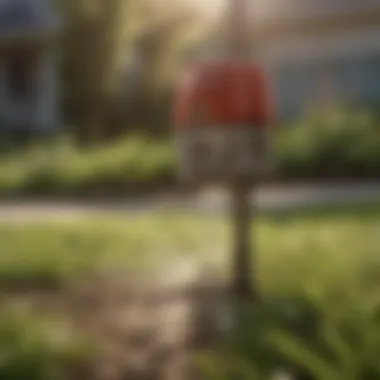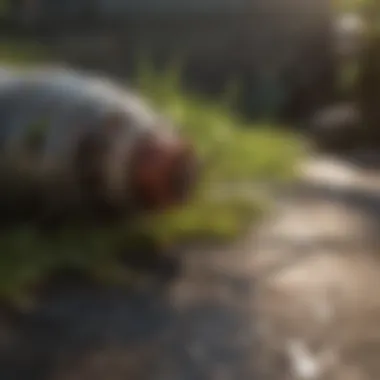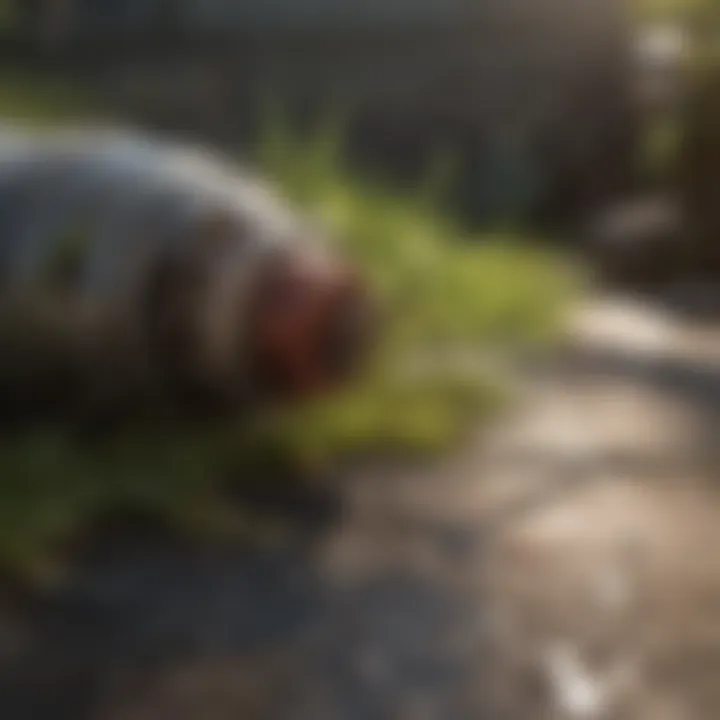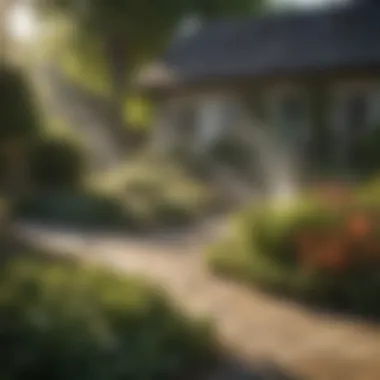Exploring the Efficacy of Sprinkler Pest Control Systems


Intro
Effective pest management is critical for both agricultural landscapes and residential environments. Sprinkler pest control systems emerge as a unique solution, bridging irrigation and pest control effectively. Understanding their efficacy involves examining various strategies, pest lifecycle management, and control methods available. This article dives into the fundamental aspects of utilizing sprinkler systems for pest control, aiming to provide homeowners and pest management professionals with valuable insights.
Understanding the Pest
Identification
Identifying pests correctly is the first step in developing an effective strategy. Common pests in residential areas may include ants, cockroaches, and aphids. Each species has distinct characteristics, making proper identification crucial. For instance, ants generally have segmented bodies, while cockroaches exhibit a smooth and oval shape. Homeowners should familiarize themselves with local pest species, using resources like Wikipedia to aid in identification.
Life Cycle
Understanding the life cycle of pests is equally important. Most pests go through several stages: egg, larva, pupa, and adult. For example, mosquitoes begin as eggs, hatch into larvae, and finally emerge as adults. Sprinkler systems can disrupt some of these stages. Regularly watering areas where pests breed can eliminate standing water, thus disrupting the mosquito life cycle.
Pest Prevention Strategies
Environment Modification
One effective method of pest control is the modification of the environment. This includes simply changing how one maintains their garden or yard. For example, reducing excessive plant growth can diminish pest habitats. Proper drainage in gardens will prevent stagnant water, reducing mosquito breeding sites.
Physical Barriers
Physical barriers provide another layer of defense against pests. Installing mesh screens on doors and windows can keep flying insects out. Additionally, using mulch or gravel can deter crawling insects by creating a less favorable environment for them.
Control Methods
Chemical Control
Chemical control remains a critical component of pest management. Sprinkler pest control systems can be integrated with chemical treatments. For instance, some systems allow the application of insecticides through the irrigation system. This method maximizes the reach of the chemical, ensuring that targeted areas receive sufficient treatment. Homeowners must follow safety guidelines when applying chemicals to protect pets and children.
Biological Control
Biological control provides a more eco-friendly approach. Utilizing natural predators is common. For example, ladybugs can assist in managing aphid populations. Sprinkler systems can foster habitats for these beneficial insects, promoting a balanced ecosystem in the garden. This allows homeowners to manage pests actively while supporting beneficial wildlife.
"Integrating technology with pest management practices can revolutionize how we protect our spaces."
Prolusion to Sprinkler Pest Control Systems
The integration of pest control methods with irrigation technology provides a contemporary solution to manage unwanted pests effectively. This section lays the groundwork for understanding how sprinkler pest control systems function, emphasizing their significance in modern agricultural and residential settings. These systems present not only an innovative approach but also the potential for sustainable pest management.
Definition and Overview
A sprinkler pest control system utilizes water to disperse chemical deterrents or create physical barriers against pests. This method combines regular irrigation practices with insecticides or natural repellents in a strategic manner designed to minimize pest activity. With pests causing damages to crops and home environments, such systems are valuable for many homeowners and farmers seeking reliable alternatives to traditional pest control methods.
The main components of these systems generally include sprinkler heads, control mechanisms, and the appropriate selection of chemicals or natural agents. The design aims to ensure even coverage of treated areas, thereby maximizing efficacy while minimizing water use, which appeals to environmentally conscious individuals.
Historical Context
Historically, pest control has evolved significantly. Traditional methods included manual application of pesticides and physical traps. As agricultural practices advanced, farmers began to recognize the efficiency of combining pest control with existing irrigation systems. The origins of using sprinklers for pest control traces back to the mid-20th century, as agricultural technology began to develop rapidly. Early implementations were basic, primarily focusing on irrigation.
Over time, advancements in chemical formulations and system design have transformed these methods into what we see today. Innovations such as programmable irrigation controllers allow for timed applications of pest control agents, paving the way for more sophisticated systems. The growing concerns for environmental impact and pest resistance further pushed the evolution of such systems, making them highly relevant in the context of integrated pest management.
Mechanisms of Action
Understanding the mechanisms of action for sprinkler pest control systems is fundamental to assessing their efficacy. These systems do not merely act as water delivery devices. They represent a strategic approach to integrate irrigation with pest management practices. Two critical elements within this mechanism are physical disruption of pests and the use of chemical agents. Evaluating these components helps highlight both their roles and benefits.
Physical Disruption of Pests
The physical disruption of pests through sprinkler systems involves the direct impact of water on the pests themselves. When the system is activated, water sprays over the targeted areas, creating a dynamic environment that can deter or displace common pests such as aphids, whiteflies, and spider mites. This method relies on simple principles of force and movement, as water pressure can physically knock pests from plants, interfering with their feeding and reproduction.
Moreover, the force of the water can create a barrier, making it difficult for pests to navigate or settle. It is especially effective when dealing with airborne pests or those that reside on the foliage. This strategy can reduce the pest population without harmful chemicals.
However, it is important to consider the timing and patterns of water application. Continuous or overly frequent irrigation can lead to waterlogging, creating an environment where beneficial organisms may also be adversely affected. Homeowners and pest control professionals must find a balance, ensuring that the water serves primarily to disrupt pest activity while promoting healthy plant growth.
Effective physical disruption of pests can significantly enhance pest management strategies.
Chemical Agents in Irrigation Water
In addition to physical methods, many sprinkler systems use chemical agents in their irrigation water to augment pest control efforts. These chemicals can be pesticides or natural deterrents that, when mixed with the irrigation water, target specific pests more effectively.
Using chemical agents has several advantages:
- Targeted Action: Proper selection of chemical agents allows for the targeting of specific types of pests, minimizing harm to beneficial insects.
- Systemic Effect: Some chemical agents can be absorbed by plants through the roots. Here, they can work internally, affecting pests that feed on the plant.
- Coverage: Applying chemicals through an irrigation system ensures even distribution, reaching areas that might be missed when applying methods manually.
It is essential to recognize the implications of using chemical agents. Compliance with local regulations and concerned consideration of environmental impacts is critical. Homeowners should seek eco-friendly options that do not compromise human or animal health, especially in residential areas. Additionally, the potential for pest resistance is a concern. If pests regularly encounter the same chemicals, they may develop resistance over time, reducing the effectiveness of these treatment methods.
Design Considerations
Design considerations play a crucial role in the effectiveness of sprinkler pest control systems. How these systems are structured directly influences their ability to manage pests while also serving irrigation purposes. A well-thought-out design ensures that the system operates efficiently, minimizes waste, and supports the overall goals of pest management and plant health.
Choosing the Right System for Your Needs
Selecting the appropriate sprinkler pest control system is the cornerstone of successful implementation. Different systems are available, each varying in performance and applicability depending on specific environments—be it gardens, lawns, or large agricultural fields. Homeowners must assess the scale of their gardens, types of pests they face, and the specific plants they wish to protect.
Consider these factors:
- Water Supply: Assess if your water source can support the sprinkler system. Systems vary in terms of required pressure and flow.
- Pest Types: Identify common pests in your area. Some systems are better suited for certain insects, while others may address a wider range of pests.
- Additional Features: Look for features such as timers, sensors, and remote control options which can enhance ease of use and effectiveness.
Layout and Coverage Areas


A well-planned layout is essential for ensuring adequate pest control coverage. Improper spacing of sprinkler heads can leave gaps in treatment that pests may exploit.
Key considerations include:
- Sprinkler Spacing: Place sprinklers to provide overlap in coverage. This helps to ensure that both the treated areas and the surrounding zones remain pest-free.
- Obstacles: Consider trees, fences, and buildings that may impede the spread of water or chemicals. Adjust the layout accordingly to avoid shaded spots where pests could thrive.
- Area Size: Larger areas may require multiple sprinkler units to ensure effective treatment. Calculate the total square footage to determine how many units are necessary.
Using a thoughtful layout, homeowners can maximize the efficacy of their systems while ensuring that they properly address pest hotspots. Not only will this save time and resources, but it will also enhance the plants' health and growth.
"A well-implemented system not only protects from pests, but also promotes an overall healthy ecosystem in your garden or crop area."
Advantages of Sprinkler Pest Control Systems
Sprinkler pest control systems have gained prominence due to their unique benefits. These systems combine irrigation and pest management, delivering a variety of advantages. Understanding these advantages helps homeowners and agriculturalists make informed decisions. The importance of these systems cannot be overstated in achieving effective control of pests in both residential and agricultural settings.
Efficiency in Coverage
One of the primary advantages of sprinkler pest control systems is their efficiency in coverage. With the ability to distribute water and pesticides evenly across a large area, these systems minimize the likelihood of pests escaping treatment. Unlike traditional methods that often rely on manual spraying, which can be uneven and labor-intensive, sprinkler systems automate the process. They ensure that hard-to-reach areas receive the same attention as more accessible spots.
Using a sprinkler system allows for quick application over vast areas. This efficiency can be particularly beneficial during peak pest seasons. Furthermore, when the water carries insecticides or other pest deterrents, it can reduce the pest population significantly in a short period. This method is not just time-saving but also encourages consistent pest management.
"An efficient coverage system increases not only pest control effectiveness but also reduces labor costs."
Integration with Irrigation Practices
Integration with existing irrigation practices is another significant advantage of sprinkler pest control systems. Many homeowners and farmers already employ irrigation systems for their crops or gardens. Adding a pest control component can maximize the use of these systems without requiring different infrastructure or excessive financial input.
This synergy means that while plants receive necessary hydration, they also benefit from timely pest management. It reduces the need for separate applications of pesticides, making it a cost-effective approach. The combined application of water and pest control substances can create an optimal environment for plants while keeping insect populations at bay.
Incorporating pest control into regular irrigation schedules can also lead to better adherence to application timings. Homeowners can set their systems to treat pests in tandem with watering, ensuring that pest management does not become an afterthought. The convenience and efficiency of this integrated approach improve overall effectiveness in both home gardens and commercial agriculture.
Limitations and Challenges
Understanding the limitations and challenges of sprinkler pest control systems is crucial for homeowners and agricultural stakeholders alike. While these systems have potential benefits, they also come with several drawbacks that one must consider. The effectiveness of any pest control method depends on a multitude of factors, including local climatic conditions, pest species, and resource availability. By evaluating these limitations, users can make informed decisions that refine their pest management strategies.
Water Use and Resource Concerns
Water usage is a significant concern when considering sprinkler pest control systems. Excessive water consumption can lead to increased costs and strain on local water resources. In certain regions, drought conditions can exacerbate this issue, making it difficult for homeowners to justify the use of large volumes of water for pest control.
Moreover, inefficient use of water can lead to runoff, which not only wastes valuable resources but also risks contaminating nearby water bodies with chemicals used in pest management. Effective design and implementation of sprinkler systems, therefore, should aim to minimize water usage while maximizing efficiency. Homeowners should consider the following:
- Scheduling Watering: Using timers or automated systems to irrigate during cooler parts of the day can reduce evaporation and ensure more water reaches the plants and pests.
- Targeted Application: Utilizing specialized nozzles or systems that deliver water directly to the target areas can limit unnecessary water use.
- Water Recycling Technologies: Exploring systems that allow for rainwater collection or recycling may reduce reliance on municipal sources.
Pest Resistance Issues
To combat this challenge, it is essential to rotate pest control practices and employ integrated pest management (IPM) strategies that include varied techniques. Here are some considerations to prevent pest resistance:
- Diversity of Control Methods: Combine sprinkler systems with other pest control methods, such as traps or biological controls, to diversify approaches.
- Monitoring Pest Populations: Regular assessment of pest populations can inform the timing and choice of pest control methods, ensuring a strategic response.
- Education and Research: Staying updated on the latest research regarding pest behaviors and resistance patterns can help inform decisions and improve long-term results.
In summary, while sprinkler pest control systems offer innovative solutions to pest management, their limitations—specifically in water usage and pest resistance—require thoughtful consideration and strategic planning. Embracing these challenges can lead to more sustainable and effective pest control alternatives.
Best Practices for Implementation
The effectiveness of sprinkler pest control systems hinges significantly on their implementation. Proper application not only enhances efficiency but also minimizes negative impacts on the environment and surrounding ecosystems. This section outlines the best practices for implementing these systems, focusing on the specifics of timing, frequency, and pest selection.
Timing and Frequency of Application
Timing plays a crucial role in pest control success. Sprinkler systems should be operated at times when pests are most active. Typically, early morning or late afternoon is ideal, as many pests, like aphids and spider mites, tend to be more active during these periods. Additionally, it is vital to consider seasonal variations when choosing application times. For instance, soft-bodied insects might emerge more in warmer months. If the irrigation system is utilized incorrectly, it may lead to ineffective pest control or unnecessary over-saturation of the area.
- Frequency of Application: Over-application can lead to pest resistance, while under-application might not yield sufficient results. Therefore, a balanced approach is needed. Regular monitoring of pest populations should inform adjustments in frequency. Following local agricultural extension guidelines can provide valuable insights into optimal frequencies based on specific pest lifecycles.
Selecting Targeted Pests
Identifying the target pests is another essential element of effective pest management using sprinkler systems. Not all pests respond equally to water-based strategies. Understanding the biology and habits of specific pests can lead to more effective control.
- Research and Identification: Homeowners should research common pests in their region. For example, systems designed to combat aphids will differ from those aimed at controlling larger pests, such as caterpillars. A well-informed approach can save resources and improve effectiveness.
- Tailored Treatments: Utilizing information about the targeted pests can allow homeowners to tailor their treatments better. This may involve adjusting the chemical agents mixed with irrigation water or modifying the timing of applications.
Incorporating these best practices ensures a smarter, more efficient pest control strategy. The right timing and targeted pest selection can significantly enhance the impact of sprinkler pest control systems, ultimately leading to a more sustainable approach in both agriculture and home gardens.
Eco-Friendly Approaches
The emphasis on eco-friendly approaches to pest control is gaining traction in various sectors, particularly among homeowners and agricultural professionals. This segment of the article highlights how sprinkler pest control systems can be designed and implemented with environmentally responsible methods. Such approaches not only target pest management but also contribute positively to ecosystem health.
Natural Pest Deterrents in Irrigation
Harnessing natural deterrents within irrigation systems elevates pest control effectiveness without harming beneficial insects. Some common natural pest deterrents include essential oils, which can be infused into the irrigation water. For instance, peppermint and clove oil have properties that repel many common pests. By integrating these substances into sprinkler systems, homeowners can create a barrier that discourages pest infestations in their gardens or lawns.
- Natural pest deterrents are preferable because they do not lead to the buildup of chemical residues in soil or water.
- They can also promote biodiversity around treated areas, allowing beneficial organisms to thrive.
- Such methods often align with organic gardening principles, which appeal to environmentally conscious individuals.
Landscapers and environment advocates recommend using native plants in garden settings. Native species are usually more resistant to local pests, reducing the need for further chemical interventions. Additionally, they tend to require less water, making them more sustainable, which supports the overall health of the local ecosystem.
Benefits of Biodegradable Chemicals
When essential, the use of chemicals can be a part of the pest control strategy in sprinkler systems. Biodegradable chemicals present a more environmentally friendly option compared to traditional pesticides. These substances are designed to break down naturally over time, minimizing their impact on the ecosystem. Here are some notable benefits:
- Reduced Environmental Impact: Since they decompose into harmless components, biodegradable chemicals prevent the accumulation of toxins in soil and waterways.
- Safety for Non-Target Organisms: These chemicals tend to be less harmful to beneficial insects and wildlife, protecting the natural balance of the ecosystem.
- Compliance with Regulations: As regulations tighten around chemical use, opting for biodegradable solutions can help homeowners and farmers meet legal requirements without sacrificing pest control efficacy.
In summary, the integration of natural pest deterrents and biodegradable chemicals into sprinkler pest control systems aligns with sustainable practices. Such approaches not only tackle the pest problem effectively but also promote overall environmental health, which is a key concern for modern homeowners and agriculturalists alike.
Economic Considerations


Understanding the economic aspects of sprinkler pest control systems is essential. Homeowners, as well as agricultural operators, must analyze the cost implications of applying these systems versus traditional methods of pest control. Economic considerations revolve around initial investments, operational costs, and long-term savings. It helps in deciding the most practical pest management solution while ensuring environmental concerns are addressed.
Initial Investment vs. Long-Term Savings
When contemplating the implementation of a sprinkler pest control system, the initial investment is often a pivotal factor. These systems can entail significant setup costs, including purchasing equipment, installation, and potential modifications to existing irrigation setups. Factors affecting the initial cost include:
- System Type: Different systems, such as drip or overhead sprinklers, have varying price points based on complexity and technology.
- Scale of Application: Larger properties may require more advanced systems, which can increase costs.
- Infrastructure Modifications: Upgrading existing irrigation infrastructure to accommodate the pest control features can add to initial expenses.
However, an effective sprinkler pest control system can lead to substantial long-term savings. Over time, these systems can reduce the need for chemical pesticides, thereby lowering pesticide costs. Additionally, as pests are managed more effectively, crop yields can increase, leading to better profits in agriculture.
A clear example of this can be seen in a study conducted by agricultural experts, showing that farms employing integrated sprinkler systems reduced their pest-related losses by up to 30%. This enhances overall profitability while ensuring sustainable practices.
Cost-Effectiveness Analysis
Cost-effectiveness analysis assesses the financial viability of employing sprinkler pest control systems compared to traditional pest management methods. Factors included in this evaluation consist of:
- Resource Utilization: Sprinkler systems often use water more efficiently, which can lead to lower utility bills.
- Labor Costs: Automating pest control can decrease the need for manual labor, thus reducing associated costs.
- Health and Safety: Minimizing pesticide usage lowers health risks for users and those around the treated area, which can save money on healthcare costs in the long term.
Investing in these systems requires careful financial analysis. Homeowners and farmers should consider both direct and indirect costs, factoring in potential government incentives for eco-friendly pest management practices.
"The decisions made regarding pest control methods have lasting economic implications, not just on current budgets but also on future agricultural productivity and environmental stewardship."
The combination of comparing traditional and modern pest control strategies allows stakeholders to make informed choices that align with both economic viability and sustainable practices.
Regional Adaptations
Climate Considerations
Climate plays a crucial role in shaping pest populations and the efficacy of pest control methods. For instance, warmer regions often experience higher insect activity and a greater variety of pests. In contrast, areas with cooler climates may see a reduction in certain pest populations during specific seasons. Understanding the specific climatic characteristics of a region helps in customizing sprinkler systems for optimal performance.
When designing a sprinkler pest control system, one must consider:
- Average temperature patterns
- Amount and type of precipitation
- Humidity levels
- Seasonal changes and their impact on pest life cycles
Proper adjustments to the chemical formulations or timings of the sprinkler system can enhance its effectiveness, depending on the climate. For example, in humid areas, using rapid evaporation substances can minimize waste and improve coverage.
Local Pest Challenges
Local pest challenges vary widely even within the same climate zone. Different pests thrive in differing environments, creating a unique set of problems for each locality. Factors such as geography, vegetation, and human activities contribute to these pest dynamics.
Some common local pest challenges include:
- Invasive Species: Certain regions may have invasive pests that require specific strategies to manage. For example, the presence of the Asian tiger mosquito in certain areas can pose unique challenges.
- Nutrient Availability: Pests often adapt to specific food sources. For instance, caterpillar infestations can intensify in areas with abundant host plants such as fruit trees.
- Resistance: Over time, some pests develop resistance to control measures, making adaptation necessary. Being aware of existing pest resilience patterns allows homeowners to implement a more efficient sprinkler system designed to combat these challenges.
Ultimately, a successful integration of sprinkler pest control systems must take both climate conditions and local pest challenges into account. It promotes more effective pest management, leading to healthier environments in agricultural or residential areas.
Future Trends in Pest Management
Understanding future trends in pest management is essential for homeowners and agricultural enthusiasts who seek efficient and eco-friendly methods to tackle pest issues. As pest populations evolve, it is crucial to adapt to these changes and incorporate innovative technologies that enhance the effectiveness of pest control measures. In the realm of sprinkler pest control systems, integrating new technologies and adjusting to modern practices can greatly improve outcomes in pest management.
Technological Innovations
Technological advancements play a pivotal role in the future of pest management. Innovations like precision agriculture, drone surveillance, and artificial intelligence now redefine how pests are monitored and controlled. Precision agriculture utilizes data analytics to provide insights on pest behavior and patterns. This technology allows users to apply pesticide only where needed, minimizing waste and environmental impact.
Drone technology enables homeowners to conduct aerial surveys of their properties, identifying pest-infested areas with high accuracy. The data collected aids in making informed decisions about when and where to use sprinkler systems for effective pest control. On the chemical front, there are continuous developments in biodegradable and targeted pesticides that can be integrated into irrigation systems, ensuring pest control is both efficient and environmentally sustainable.
"Innovations in technology not only enhance pest control efficiency but also address emerging environmental concerns."
Integration with Smart Home Systems
Integrating sprinkler pest control systems with smart home technology is an emerging trend that brings a new level of convenience and efficiency. Smart home systems can automate the management of pest control through the use of sensors and intelligent data management. Homeowners can install sensors that monitor pest populations, soil moisture, and weather conditions, all of which contribute to when to activate the sprinkler system.
This integration allows for real-time adjustments based on specific needs. For example, if a certain pest threshold is met, the sprinkler system can automatically activate to dispense a targeted solution. Moreover, smart systems can be programmed to operate during optimal times, reducing unintended exposure to beneficial insects.
Homeowners can also control these systems remotely, providing flexibility in management and reducing the time required for manual operation. As a result, integrating sprinkler systems with smart home technology not only enhances pest control effectiveness but also offers peace of mind for homeowners seeking proactive measures against pest infestations.
Case Studies and Success Stories
Case studies and success stories provide invaluable insights into the real-world applications of sprinkler pest control systems. These narratives not only showcase the effectiveness of such systems but also highlight various challenges faced by users. By examining practical examples from agriculture and home settings, we can better understand the strengths and limitations of these pest management tools. This section aims to illustrate how sprinkler systems can optimize pest control and improve outcomes for users.
Effectiveness in Agriculture
Agriculture often faces significant pest challenges, impacting crop yields and farmer income. Sprinkler pest control systems have shown substantial results in various agricultural settings. One notable case involves a large-scale farm in California that implemented a state-of-the-art sprinkler pest control system alongside traditional irrigation methods. The farmers reported a stunning decrease in pest populations, particularly aphids and beetles, which had plagued their crops in previous seasons.
The success was attributed to the dual action of the sprinkler systems. First, through physical disruption, the water flow dislodged pests from their resting places. Secondly, chemicals mixed in the irrigation water targeted pests effectively without harming beneficial insects. This method not only protected the crops but also reduced the need for more harmful pesticides, aligning with eco-friendly agricultural practices.
"Our pest problems plummeted, and we saw healthier plant growth as a result. The sprinkler system paid for itself within two growing seasons," said the farm manager.
Homeowners’ Experiences
Homeowners have also found success using sprinkler pest control systems. One homeowner in Florida reported dealing with a severe mosquito problem that significantly affected their outdoor living space. By installing a sprinkler system designed for pest control, the homeowner was able to manage mosquito populations efficiently.
The system was programmed to activate during peak mosquito activity hours. This approach not only provided relief to the homeowner but also minimized the exposure of children and pets to harmful chemicals. After several weeks, the family noted a drastic decrease in mosquito presence when compared to previous years, enhancing their overall outdoor experience.
In addition, many homeowners appreciate the convenience of such systems. Unlike traditional pest control methods, which often involve manual application, sprinkler systems provide a more automated solution, making it easier to maintain a pest-free environment.
These detailed case studies accentuate the practical advantages of sprinkler pest control systems. They demonstrate both the versatility and efficacy of these systems, proving beneficial for agricultural and residential uses alike.
Regulatory Considerations


Regulatory considerations are a critical aspect of implementing sprinkler pest control systems effectively. These regulations vary widely by region and directly influence how such systems can be designed and utilized. Understanding and adhering to these laws is essential for both homeowners and pest management professionals to ensure compliance and avoid potential penalties. Key points in this area include legal requirements surrounding chemical usage, water resource management, and ensuring public safety.
Compliance with Local Laws
Compliance with local laws forms the backbone of any successful pest control strategy. Each jurisdiction has specific regulations that dictate what kind of pesticides can be used, the times they can be applied, and under what conditions. These regulations are designed to protect both the environment and public health. It is imperative for homeowners to research local ordinances before installing a sprinkler pest control system.
A few steps to ensure compliance include:
- Check local regulations: Start by reviewing local agricultural extensions or governmental resources for pest management regulations.
- Consult with professionals: Engaging a licensed pest control professional can provide guidance around compliance issues.
- Keep records: Document all applications made through the sprinkler system, including the type of substance applied and the conditions during application. This may aid in accountability.
Assessing Chemical Regulations
When evaluating chemical regulations, it is crucial to understand both the legal limits on what can be used and the impact of these substances on human health and the ecosystem. Chemicals used in pest control can have multifaceted effects, sometimes leading to unintended consequences, such as harming non-target species or contaminating water supplies.
Evaluating chemical regulations involves several important components:
- Active ingredients: Knowing which active ingredients are allowed or banned locally is fundamental. Some chemicals pose higher risks than others and may require special permits for use.
- Application methods: Regulations often specify how and when chemicals can be applied. Sprinkler systems may need to employ certain processes to comply with these rules, such as buffer zones to protect sensitive areas.
- Environmental impact: Homeowners must also consider the broader environmental implications of the chemicals they choose. Opting for biodegradable or less harmful alternatives may not just be a regulatory choice but also a safer one for the environment.
Interaction with Other Control Methods
Interaction with other control methods is a significant topic in understanding how sprinkler pest control systems can enhance pest management strategies. Sprinkler pest control systems should not be viewed in isolation. Instead, they form a part of a more extensive framework of pest control tactics that, when integrated, can yield greater efficacy.
By combining different methodologies, homeowners can achieve more comprehensive pest management outcomes. For instance, utilizing biological control methods alongside sprinkler systems can target pests effectively while maintaining ecological balance. This integrated approach allows for a reduction in chemical usage, aligning with eco-friendly practices.
Some key benefits of integrating sprinkler systems with other control methods include:
- Broader Coverage: Sprinkler systems can address specific pest populations while other methods can control pests that may not be effectively managed by water alone.
- Reduced Resistance: Frequent application of a singular method can lead to resistance in pests. By alternating strategies, it is possible to minimize this issue.
- Cost-Effectiveness: A diversified pest control strategy can potentially lower long-term costs by reducing the need for expensive chemical treatments.
However, it is crucial to ensure that the methods chosen are compatible. Mismatched strategies can lead to unforeseen problems, like harming beneficial insects. Therefore, careful planning and monitoring are required to maximize the benefits of this integrated approach.
Integrated Pest Management Strategies
Integrated Pest Management, or IPM, is a comprehensive strategy that involves multiple practices to manage pests sustainably.
When using sprinkler systems as part of an IPM strategy, homeowners benefit from the following:
- Monitoring Pest Populations: Before applying any control methods, it's essential to track pest populations. Sprinkler systems can assist in this by making it easier to observe changes in insect populations after application.
- Setting Economic Thresholds: It's vital to understand when control measures are necessary. IPM incorporates economic thresholds, which help decide the point at which pest damage would justify control measures, ensuring that efforts are applied only when truly needed.
- Selection of Compatible Controls: In an IPM framework, integrating the sprinkler system with other controls like biological controls ensures a balanced approach that monitors and manages pests effectively.
"The goal of Integrated Pest Management is to minimize risks to human health and the environment while effectively controlling pest populations."
The collaboration of different pest control methods in an IPM strategy can enhance the overall effectiveness. Homeowners are encouraged to follow guidelines provided by IPM practitioners in their locality.
Combining Sprinkler Systems with Traps
Combining sprinkler systems with traps presents a practical application for controlling pests effectively within both residential and agricultural settings. Traps serve to capture pests and prevent them from causing damage. Utilizing both methods results in a more layered defense mechanism.
This combination allows for:
- Real-Time Monitoring: Traps can alert homeowners to pest presence, while sprinkler systems can apply treatment accordingly.
- Targeted Actions: Traps help in identifying specific pests that are present. This allows for more precise application of chemicals if needed, reducing unnecessary pesticide use.
- Cost Efficiency: Both methods together can minimize costs by reducing pests more efficiently than one method alone. Regularly monitoring traps ensures that the pest control strategy remains effective and adjustments can be made as necessary.
Using both systems requires some planning. Homeowners must consider the correct placement of traps to ensure they work alongside the sprinkler system effectively. Appropriate timing for both methods will maximize the potential benefits.
Educational Resources
The importance of educational resources within the context of sprinkler pest control systems cannot be understated. Knowledge is fundamental for effective pest management. Homeowners and professionals alike must understand both the technologies and strategies available to them. Proper education can significantly enhance the efficacy of pest control measures, leading to more successful outcomes.
Training for Professionals
Training is essential for pest control professionals to effectively implement sprinkler pest control systems. This involves understanding the mechanics of these systems, identifying the various pests they target, and knowing when to apply treatments. Training programs should cover several key areas:
- System Operation: Professionals must learn how to operate sprinkler systems in a pest control context. This includes programming schedules and understanding how water application affects pest behavior.
- Pest Identification: Knowing which pests are present is crucial. Training should include modules on identification skills and understanding the pest life cycle.
- Risk Assessment: Professionals need the ability to evaluate potential risks before implementing pest control measures. This step ensures that the right system is in place for specific pest problems.
Educational institutions and pest control associations often offer structured training programs. These can include workshops, online courses, and certification programs.
"Investing in training fosters a knowledgeable workforce, equipped to make informed decisions in pest management efforts."
Moreover, keeping up-to-date with the latest research and advancements is vital. Access to academic journals and industry conferences can provide insights into emerging trends and new methodologies.
DIY Resources for Homeowners
For homeowners who wish to tackle pest issues independently, numerous DIY resources are available. An informed approach can save costs while addressing pest problems effectively. Here are some essential aspects homeowners should consider:
- Guides and Manuals: Many organizations offer guides that detail how to set up and utilize sprinkler systems for pest control. These documents often include step-by-step instructions tailored to specific pests.
- Online Tutorials: Websites like YouTube provide visual demonstrations on how to implement various pest control strategies, from installing systems to monitoring effectiveness.
- Community Forums: Engaging in online communities such as Reddit allows homeowners to share experiences and tips. These platforms can be invaluable for gaining practical insights from others who have successfully managed pests using sprinkler systems.
Homeowners must also stay informed about the potential challenges associated with DIY pest control. Resources that address the limitations of sprinkler systems can help in setting realistic expectations. Additionally, always consider potential environmental impacts and local regulations.
In summary, educational resources are pivotal for both professionals and homeowners involved in utilizing sprinkler pest control systems. Proper training and access to DIY materials can enhance understanding and implementation, ultimately leading to a more effective pest management strategy.
Culmination
The discussion on sprinkler pest control systems is pivotal in understanding modern pest management techniques. These systems have revolutionized how homeowners tackle infestations while simultaneously managing their landscaping and garden irrigation needs. This article underscores several key elements:
- Efficiency and Effectiveness: Sprinkler systems enable effective pest control through efficient distribution of both water and treatment substances. This dual-role contributes to healthier plants while simultaneously repelling nuisances.
- Integration with Existing Systems: Homeowners can easily integrate pest control functions within their current irrigation setups. This minimizes additional costs and labor while maximizing the utility of technology already in place.
- Eco-Friendly Solutions: The discussion emphasizes environmental considerations. Utilizing biodegradable agents within irrigation systems highlights a growing trend towards sustainable practices in pest control.
- Economic Insights: Understanding the economic dynamics of initial investments versus long-term savings is crucial. Homeowners are empowered to make informed decisions about pest management strategies that best suit their financial needs and priorities.
"Understanding the balance between effective pest control and environmental sustainability is essential for modern homeowners."
Summary of Key Points
- Sprinkler pest control systems merge irrigation with pest management, providing dual benefits.
- The efficiency of coverage allows for effective pest disruption.
- Integration with existing irrigation set-ups simplifes implementation for homeowners.
- Eco-friendly methods support sustainable practices in pest management.
- Cost-effectiveness hinges on a balance of initial investment and long-term benefits.
Future Outlook for Sprinkler Pest Control Systems
The future of sprinkler pest control systems appears promising. As technology advances, expect:
- Innovative Solutions: Developing smart technology that integrates with household systems will enhance user experience and monitoring capabilities, allowing for precise timing and delivery of pest control measures.
- Increased Customization: Future systems could offer customizable features tailored to specific pest populations and plant types, maximizing effectiveness.
- Resource Management Innovations: Improved water management techniques and biodegradable agents will likely emerge, making pest control more sustainable.
- Education and Awareness Campaigns: As knowledge spreads, homeowners will be better equipped to utilize these systems effectively, leading to better pest management practices overall.







